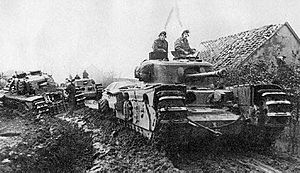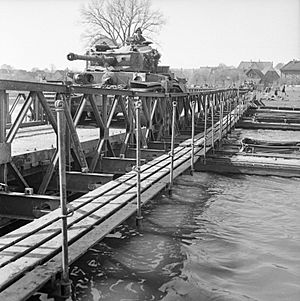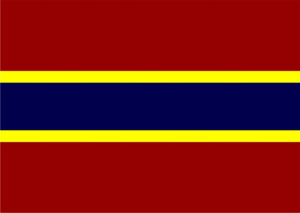Fife and Forfar Yeomanry facts for kids
Quick facts for kids The Fife and Forfar Yeomanry |
|
|---|---|

Cap Badge of The Fife and Forfar Yeomanry
|
|
| Active | 1794–1956 |
| Country | |
| Branch | |
| Type | Yeomanry |
| Role | Armoured |
| Size | One Regiment |
| Nickname(s) | The Fifes Knife and Forkers |
| Motto(s) | Pro Artis Et Focis Latin: "for Hearth and Home" |
| March | Quick March (band) - Wee Cooper of Fife; Slow March (band) Bonnie Dundee |
| Engagements | Second Boer War World War I
|
| Insignia | |
| Regimental Colours |  |
The Fife and Forfar Yeomanry (FFY) was a special type of army unit called a Yeomanry Regiment in the British Army. It was formed way back in 1793. This unit was involved in some big wars, including the Second Boer War, the First World War, and the Second World War. In 1956, it joined with another unit called the Scottish Horse to become the Fife and Forfar Yeomanry/Scottish Horse. Today, its history is kept alive by "C" Fife and Forfar Yeomanry/Scottish Horse Squadron, which is part of The Scottish and North Irish Yeomanry in Cupar, Fife.
Contents
History of the Fife and Forfar Yeomanry
How the Unit Started
The story of the Fife and Forfar Yeomanry began with two separate groups. The Kirkcaldy Troop was set up in 1797. It later became the Fife Yeomanry Cavalry but was closed down twice, in 1828 and 1838. It started up again in 1860 as the 1st Fifeshire Mounted Rifle Volunteer Corps.
Meanwhile, the Forfar Yeomanry was formed in 1794. It also closed down in 1828 and again in 1862. It was re-established in 1876 as the 1st Forfarshire Light Horse Volunteer Corps.
Serving in the Second Boer War
In 1899, during the Second Boer War in South Africa, the British government needed more soldiers. They created the Imperial Yeomanry (IY), which allowed volunteer groups to join the fight. The Fife and Forfar units worked together to form the 20th (Fife and Forfarshire Light Horse) Company. This company was part of the 6th (Scottish) Battalion of the Imperial Yeomanry.
In 1901, the two separate units, the 1st Fifeshire Mounted Rifle Volunteer Corps and the 1st Forfarshire Light Horse Volunteer Corps, officially joined together. They became the Fifeshire and Forfarshire Imperial Yeomanry. By 1908, the word "Imperial" was dropped from their name. At this time, the regiment was based in Kirkcaldy.
The First World War (1914–1918)
When the First World War began in 1914, many soldiers in the Territorial Force (a home defence army) volunteered to serve overseas. Because of this, units like the Fife and Forfar Yeomanry were split into different "Lines":
- 1st Line (1/1st Fife and Forfar Yeomanry): These soldiers were sent overseas. They fought in Egypt and Palestine in 1917 and 1918. Later, they moved to France in 1918. They became the 14th (FFY) Battalion of the Black Watch regiment.
- 2nd Line (2/1st Fife and Forfar Yeomanry): This group was formed in 1914 for home defence. They were first part of a mounted brigade. Later, they became a cyclist unit in Northumberland and then moved to Ireland, where they stayed until the war ended.
- 3rd Line (3/1st Fife and Forfar Yeomanry): This group was formed in 1915 to train new soldiers. They provided replacements for the 1st and 2nd Line units. This group was disbanded in 1917.
Between the World Wars
After the First World War, in 1920, the regiment was re-established in the Territorial Army. It was decided that most Yeomanry regiments would change roles. So, in 1921, the Fife and Forfar Yeomanry became the 2nd (Fife and Forfar) Armoured Car Company. This unit was later renamed the 20th (Fife and Forfar) Armoured Car Company and became part of the Royal Tank Corps. In 1939, it joined the Royal Armoured Corps.
As another war in Europe seemed likely in 1939, the Territorial Army was expanded. The Fife and Forfar Yeomanry grew into an armoured regiment, becoming the 1st Fife and Forfar Yeomanry. They also formed a new, duplicate unit called the 2nd Fife and Forfar Yeomanry in the same month.
The Second World War (1939–1945)
- 1st Fife and Forfar Yeomanry: This unit went to France in September 1939 as a reconnaissance (scouting) regiment. They were part of the British Expeditionary Force. They took part in the Dunkirk evacuation in June 1940, where many British soldiers were rescued from France. Later, in March 1945, they were involved in the crossing of the Rhine River in Germany.
- 2nd Fife and Forfar Yeomanry: This unit was part of the Normandy landings in June 1944, which was a huge invasion of German-occupied France. They fought in several important battles, including Operation Epsom in June 1944, Operation Goodwood in July 1944, Operation Bluecoat in August 1944, and the Battle of the Bulge in December 1944.
After the Wars
After the Second World War, in 1947, the regiment returned to its role as an Armoured Car Regiment. In 1956, it joined with the Scottish Horse to form the Fife and Forfar Yeomanry/Scottish Horse. Even though this combined unit was disbanded in 1975, its history continues through "C" Fife and Forfar Yeomanry/Scottish Horse Squadron, which is based in Cupar, Fife.
Memorials
There is a special book of remembrance for the regiment at Cupar Old Parish Church. Also, a stone plaque at Tulliallan Old Churchyard remembers "all ranks – The Fife Light Horse and The Fife and Forfar Yeomanry 1860–1918."
Battle Honours
Battle honours are special awards given to military units for their bravery and success in battles. The Fife and Forfar Yeomanry's battle honours are shown on their guidon (a special flag). This guidon is now kept at Cupar Old Parish Church. When the regiment joined with the Scottish Horse, these honours were passed on to the new unit's guidon. Today, they are represented on the guidon of the Queen's Own Yeomanry.
Here are some of the important battle honours awarded to the Fife and Forfar Yeomanry:
| Second Boer War | South Africa 1900–01 |
| First World War | Somme 1918, Bapaume 1918, Hindenburg Line, Épehy, Pursuit to Mons, France and Flanders 1918, Gallipoli 1915, Egypt 1915–17, Gaza, Jerusalem, Tell 'Asur, Palestine 1917–18 |
| Second World War | Dunkirk 1940, Cheux, Bourguébus Ridge, Le Perier Ridge, Scheldt, Ourthe, Rhineland, Rhine, North-West Europe 1940, '44–45 |
Guidons
The regiment's guidon, which is like a special flag, is kept at Cupar Old and St Michael of Tarvit Parish Church.
Uniform
The cap badge of the FFY shows a mounted knight, known as The Thane of Fife. This badge was also worn on the collars of officers and soldiers. Senior Non-Commissioned Officers wore it on their arms above their rank stripes. The regiment wore the black beret of the Royal Tank Regiment. They also had a special stable belt with the regimental colours of crimson (dark red) and yellow, with a dark blue stripe.
Regimental Music
The quick march song of the Regiment was "Wee Cooper of Fife."
Affiliated Regiments
The Fife and Forfar Yeomanry was connected to the following regiment:
 United Kingdom – 1st The Royal Dragoons
United Kingdom – 1st The Royal Dragoons
The Fife and Forfar Yeomanry Locomotive
A special train engine, a British Rail Class 55 'Deltic' diesel locomotive named D9006 (later 55006), was named after the Regiment. This engine was built between 1961 and 1962. It was designed to pull high-speed passenger trains on the East Coast Main Line, which runs between London King's Cross and Edinburgh.
See also
- Imperial Yeomanry
- List of Yeomanry Regiments 1908
- Yeomanry
- Yeomanry order of precedence
- British yeomanry during the First World War
- Second line yeomanry regiments of the British Army




